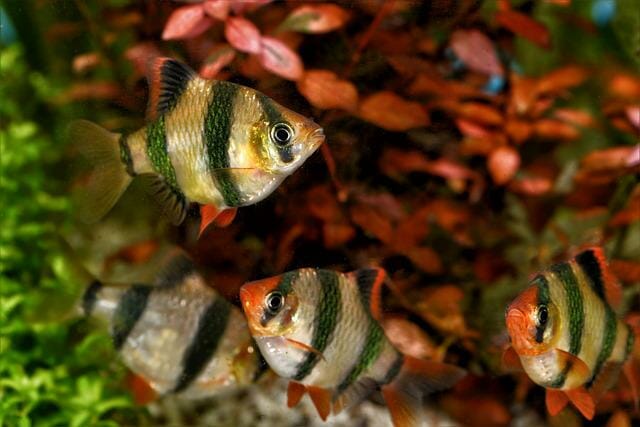Tiger Barb Tank Size: Best Tank Size and General Care Guide

You can find tiger barb fish in tropical and subtropical waters worldwide. They are commonly found in rivers and streams but are also known to inhabit brackish water habitats. This is a popular aquarium fish known for its ferocious, beautiful styles.
The recommended tank size for your tiger barb is 20 gallons to thrive. In addition, a few additions such as live plants and good quality fish food will help your tiger barb thrive in its new home.
Table of Contents
What Is the Minimum Tank Size for a Tiger Barb?
A tiger barb can be kept in a tank as small as 10 gallons. However, they’re happier in tanks that are at least 20 gallons. Tiger barbs swim around and interact with other fish in their territory, so a larger tank benefits their mental health and social development. In addition, a larger tank will allow you to keep more tiger barbs without them feeling crowded.
Tiger Barbs Facts & Overview
The tiger barb is a hardy fish that can handle many water conditions. They are considered good community fish and are great for adding color to your aquarium. Their natural diet consists of small invertebrates, and they will eat flake food, crushed flake food, and blood worms. The tiger barb is a schooling fish that should be kept in a group of at least six. They are active and playful and significantly add to any community aquarium.
Habitat and Tank Conditions
Tiger barb fish require a tank size of at least 20 gallons. They are tank keepers and, as such, require a habitat that is both stimulating and suitable for their needs. It’s essential to keep the pH levels high, so the tank is free of toxins from decaying plants and food. Keep an eye on the temperature, which should be between 77-82 degrees Fahrenheit, to support healthy aquatic life.
Additionally, strategically raise or lower the water level in your tank to give your fish a variety of habitats to explore and play in. Make sure your habitat has plenty of hiding spots for your tiger barb tank. In addition to keeping tiger barb fish in captivity, always watch for tiger barb fish in the wild so you can appreciate their beauty and uniqueness.
Typical Behavior
The tiger barb is a very active fish that should be kept in a well-maintained aquarium. They are good at schooling and can be entertaining to watch. They are also aggressive towards other fish, so it is essential to have at least six of them for best results. In addition, the tiger barb is a good fish for beginner aquarists. They are easy to care for and will not require a lot of specialized equipment or maintenance.
Tank Setup
To keep your tiger barb in good health, it is vital to have a well-maintained tank. Please ensure the pH levels are high and adjust the water level as needed to provide variation in habitats for them. They can be housed with other small fish they will not bully or aggress against. In addition, provide plenty of hiding spots for your fish so they can relax and enjoy their habitat.
Tank Mates
The tiger barb is a good fish for beginner aquarists and can be housed with other small fish that it will not bully or aggress against. The tiger barb is a territorial fish and should be kept with other similar-sized fish in a well-maintained aquarium. Additionally, they are good with some bristlenose fish, barbs, plecos, and loaches.

Appearance
The tiger barb is a brightly colored fish that can range in color from light olive to bright red. They have long barbels at the base of their noses and pronounced cheekbones. The Tiger Barb also has a long, thin tail that helps it swim quickly through the water. In addition, they have large scales that give them a reasonable degree of protection.
Diet
The tiger barb is a predatory fish and will require a diet that includes live and frozen aquatic meats, such as brine shrimp, bloodworms, and daphnia. They also enjoy smaller crustaceans like crayfish and shrimp. In addition, they will eat vegetables, such as cucumber and lettuce, when they can get them.
How to Care for Tiger Barbs
Tiger barb fish are beautiful fish that need a lot of care to thrive. They need a temperature range of 77-82 degrees Fahrenheit. They also need an aquarium net to humanely remove tiger barbs if you can’t keep them (or if they outgrow the tank). Feed them small flakes, pellets, or tablets once per day and change their water regularly to prevent debris and bacteria buildup.
Keep an eye on the water quality and temperature, and keep an aquarium net handy in case you need to remove tiger barb fish. Tiger barb fish are tropical fish that needs the care to thrive. In addition, they should be kept with other similar-sized fish and have a good tank that is well maintained.
Breeding a Tiger Barbs
The breeding process is simple: each male will chase away any other males from the designated territory, then slowly start to court the female by swimming around her in circles until she accepts him. Once she does, they should spawn (lay eggs) within 24 hours, and the eggs can be fertilized by either the male or female parent.
Newly hatched tiger barb fry will require plenty of food and water before they grow into healthy fish. Additionally, they should be kept in groups of at least six fish to ensure they have a protected place to hide and somebody to watch out for.

Are Tiger Barbs Suitable for Your Aquarium?
Tiger barbs can be a great addition to your aquarium. They’re docile and will not harass other fish in your tank. They also like calmer waters, making them an ideal choice for tanks with cold water temps. Be sure to research the different tiger barbs before adding one to your aquarium – some have aggressive tendencies!
Make sure you get the correct size for your tank – a tiger barb that’s too small will be unable to survive in the water, while one that’s too large can cause damage to other fish in the tank. Additionally, keep your tank well-maintained – a dirty aquarium will give tiger barbs nowhere to hide and can lead to aggression.